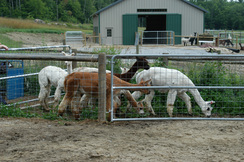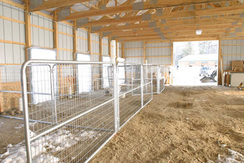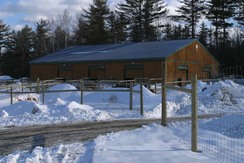|
February 02, 2011
Barns, Paddocks and Pasture Design
Managing Your Herd Through Facilities Planning
By: Carol Karsten

Catch-pen in Paddock Chute

Pen Areas in Breeding Barn

Girls' Barn Connected
Originally published in International Camelid Quarterly.
Introduction
As with so many elements of alpaca breeding, there is no one correct way to properly house and manage one’s alpaca herd. However, proper planning for pasturing and housing of your alpacas is one of the single most important elements in assuring their health and well-being. The greater the forethought given to planning barn and paddock layout and integration of pastures to these, the lower will be the stress factor in dealing with day-to-day husbandry issues.
Having started out as a small breeder and now, managing a herd of over 85 alpacas, I have bought two farms, built several different types of barns, retrofitted an antique barn, and planned layout for paddocks and access to pastures with respect to each. While I consider my work far from complete and subject to ongoing refinements, I can pass along some of my tips on what has worked and some notes on the planning process.
Plan for the future size of your herd
Even if you are starting with two bred females and a couple of gelding males, think seriously about what your future size requirements will entail. In my first year of operation, I started with only three bred females and two geldings – by the end of that year my herd had grown to six bred females, several cria and three geldings. I found that planning for three separate pen areas right away obviated major alterations for the following two years.
Pens to Paddocks to Pastures
This is one planning element that, regardless of the location, type of animal housing or size of my herd, has stayed with me in my six years of alpaca farming. When I held down a day-job that required my being off the farm for ten or more hours a day, I had to ensure that my alpacas could move freely from the barn to outdoor paddocks to the pastures. I built my barn with maximum interior floor planning flexibility. Only a grain room with a delivery door and a small vet room were fully framed in. A brushed concrete aisle ran the width of the barn, in front of the grain room/vet room area, with three separate pen areas with gates to each leading off the aisle. I made my pens using corral panels initially. The three pens afforded me an instant cria pen, when needed, which doubled as a weaning area. This was the middle pen, and I made sure I had a gate panel between this and my mom/cria area, since when it was not in constant use, they could spread out and use it. Why three pens? Well, I had taken one look at my big, sweet gelding boys and knew right off that my females would have cria that would soon enough be six month old weanlings, and these little ones would need to be in a separate pen. Each pen area led out, through Dutch doors, to separate paddocks. Each paddock had a gate, leading to a series of five foot wide “chutes” that led to each of three pastures. I made liberal use of gates with spring-loaded Kiwi latches throughout. Each of my three groups of alpacas (when there were three groups) could move freely to the pasture, then back to the paddocks or into their separate pen areas in the barn, where they could have water from the automatic waterers.
Chutes were a new thing to my fence contractor. However, he knew a good thing when he saw one, and he began to recommend this method of paddock to pasture management to all his subsequent alpaca breeder customers.
Chutes and Catch-pens
When you need to catch an alpaca, good luck -- if you give them wide open spaces -- in snaring one! I found that the chutes had another nice feature: put in a couple of extra gates with Kiwi latches in the middle, with about nine feet between each gate, and you have a nice little catch-pen in which to do monthly wormings and any other procedures as necessary, with the added benefit of sunlight while performing these ministrations. Close the group of alpacas into the chute, open the forward gate to the “catch-pen,” let a number of alpacas go in, follow them in. You won’t be flying around trying to corner them this way and, when they are done, open the other gate and let them go happily out to the pasture. With 85 alpacas, I and one assistant handling the animals can manage to do monthly worming in about an hour and a half this way and no one, alpaca or person, is the worse for wear. I employ wider (9 foot) chutes around the paddocks, the girls and kids start out in their back paddock, enter the catch-pen through the first gate, we catch ten or so, finish shots, and release them out the second gate, to the chute leading to the girls’ front paddock. And so on, until we are done. From the paddock, the animals can choose to head out to the pasture.
Magic Squares
I decided I needed a place in the interior of my barn that could afford us the same flexibility to manage the animals in much the same manner. After all, with our cold winters in the Northeast, doing herd health outside is just not practical in all four seasons. I came up with what I call the magic square. In my girls’ and cria barn, I have three large pens that flow the entire length of the barn, with gates permitting or barring access to each, as the need arises. In the middle pen, I have what I call the magic square. It is made up of four wooden fence posts, with four gate panels, each with a Kiwi latch. We have poured concrete in this area to facilitate easy leveling of our digital scales. Because we can open any of the four gates, this is our favorite place to do a series of ultrasounds when the vet is here, as well as to weigh the animals on a regular basis. I use the area to take weights on the animals, particularly the cria and weanlings, to check their development.
The Shape of Things
Long and skinny – there is no better shape than that in my experience, if you prefer to give your alpacas lots of room to roam, but still want to be able to catch them without stressing them. Not only are paddocks great when set up that way, but so are pastures. When you want those young alpacas to run freely and you are dealing with limited acreage, think long and lean – the kids can still run long distances and build muscle. With pastures, of course, you want them wide enough to afford access to turn around with your tractor and other farm equipment. I always make sure there is an external gate leading to each pasture to gain entry with large farm vehicles. Chutes leading to pastures can then be kept narrower. I do like to have skid-steer access to all my chutes, so I make the chutes between 5-6 feet wide.
Doors, Doors and More Doors!
If I could do it over, my girls’ barn would have even more doorways and pen areas than it already does, as well as more corresponding paddocks. In a large or growing herd, there are needs to divide girls up so many times during the year – some girls are more food-aggressive than others and gain weight, some will lose weight if forced to fight for food. Being able to separate the last-trimester females from ones due later on in the year or the maidens, for example, in order to ensure these girls get what they need in terms of nutritional extras is another very important reason to be able to divide the herd into smaller groups. When the time comes for weaning, having the flexibility to move the moms, leaving the kids with the comfort of the same society and pastures in which they have grown up, makes sense. If you are planning on a pen to paddock to pasture approach, the more doors out increases the flexibility you have to subdivide the herd when necessary.
When I built my big boys’ barn which is also my breeding barn, I knew I wanted a lot of pen areas. I planned easy access by extending existing chutes to and from the girls’ barn. There are twelve Dutch doors in this 42’X60’ barn. There are eight full-time breeding pens with adjoining outside paddocks, a larger non-breeding and not actively breeding corner pen area on one side with direct pasture access, and another larger pen for visiting females and cria with paddocks and pasture access on the other side. I also wanted a large center aisle to direct females from the girls’ barn all the way down a chute that, with a couple of gate changes, would take them directly to the male to whom I planned to breed them. If necessary, we are set up to shear in the breeding barn as well, however to save time this year, we ran the big boys up the connecting chute to the main barn with just a couple of gate changes. The ease with which we moved them to the big girls’ barn was proof to me that we had things working right.
Managing to Your “Personal Worst” Day
Asked to pick the most stressful day of the year, most alpaca breeders will likely pick shearing day. If you can make your barn work for you on the most stressful day of the year, it will be your best friend all year round. When I planned my girls’ barn, I did so with shearing day in mind, because it truly does involve more people who have had little or no experience in animal handling helping out, the animals are contained for hours at a time, there is loud noise and the fleece is flying! The barn features a horse stall mat-lined aisle that runs the entire 80 foot length, with large double Dutch doors at each extreme. On one side of the aisle is the grain room, warm room and vet room, as well as two quarantine pens with attached paddocks. On the opposite side of the aisle are the animal pen areas. After our most recent shearing day, I have decided to get my electrician to hard-wire halogen spots to flood the aisle with light. Using I-bolts at floor level, we employ two shearing stations – one animal is being lowered to the ground on a set of ropes and pulleys while another is being shorn. Armed with a dozen pair of toenail clippers, I trim toenails on each waiting animal while our shearer is busy taking the heavy winter coat off the other. With the multiple pen areas, we use the middle pen to herd twenty animals in readiness and use the magic square to contain the next couple of animals “on deck.” When shearing is complete, the animal is released into the front pen. We take a break after each group of twenty, at which time I let the group out to the pasture. Starting around 8:30 am and taking twenty minute breaks after each group of twenty, an hour for lunch, the last animal “hits the ropes” around 4:30 pm. Of course, it helps to have a shearer who does alpacas in record time! I also employ a person who handles fiber and skirts the prime blanket fleece at a skirting table down at the end of the aisle. The same person puts pre-made name tags in each 55 gallon plastic bag (held in large-capacity drums, one for prime blanket, another for seconds, at each shearing station). Two teams of two-three people keep the animals coming. The horse stall mats make sweeping between animals a breeze.
Summary
A well-planned barn and paddock arrangement is only one arrow in the quiver of the best managed livestock operations, but it certainly can make everything from monthly wormings, to quarterly herd health days to annual shearing day a little easier on everyone involved, most particularly one’s alpacas. At the end of the day, though, when you manage to the objective of minimizing stress on your alpacas – or any livestock for that matter – you should be rewarded with a healthier herd. And that is a goal that pays dividends, well beyond your efforts.
|